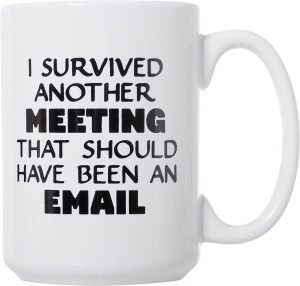This post contains affiliate links.
U.S. workers attend 62 meetings every month on average (3 per workday) and consider more than half the time is wasted, according to Atlassian. With millions of unnecessary and poorly run meetings every day the business costs are estimated at $37 billion each year. The impact on employee productivity is even greater by reducing the time employees have available time to do the rest of their work and causing confusion.
There are only three reasons to ever call a meeting: 1) to reach a decision that involves multiple stakeholders, 2) when the topic of the meeting is complex and requires active discussion between the attendees, and 3) for major announcements.

Meetings are a necessary part of every business operation and won’t be eliminated – but this also makes them one of the single biggest opportunities for improvement. Well-run meetings can help make everyone more effective and productive, and think of the morale boost when staff feel that their time is valued and respected.
Meetings are a great trap. … they are indispensable when you don’t want to do anything.
John Kenneth Galbraith
In many organizations “Death by Meeting” is a reality. Meetings suck time and energy from the attendees and create frustration and a sense of hopelessness. Attendees feel trapped and don’t pay attention – they spend the time scrolling on their phone or zoned out – but they are not focused on the purpose of the meeting if they even know what the meeting is trying to accomplish.
Why Call A Meeting: There are many justifications given for calling a meeting, but most scenarios have better solutions that are more effective and less costly than meetings. There are only three reasons to ever call a meeting and we cover them below.
Call A Meeting To Make Decisions

Not every decision needs a meeting, in fact, most decisions should not require a meeting. When you only need one person to make a decision simply get the decision from that person. However, many important decisions do require input from multiple groups and should be done in a meeting setting.
Before diving right into meetings for the purpose of making decisions, its important to truly understand what a decision actually means. Professor William Starbuck of the University of Oregon’s Charles H. Lundquist College of Business describes a decision as follows:
‘Decision’ implies the end of deliberation and the beginning of action
William Starbuck
This does a good job of explaining the concept, but business leaders still fail to execute the important aspects of a decision, as author Peter Drucker explains:
A decision has not been made until people know:
Peter F. Drucker
– the name of the person accountable for carrying it out;
– the deadline;
– the names of the people who will be affected by the decision and therefore have to know about, understand, and approve it
Expert Tip: Decisions are a gate for action and action is the important part of business. All action items need to have an individual person as the owner (not a department), with a defined deliverable and commit date.
Now that we know the meaning of a decision, the decision-making meeting becomes easier to understand and the importance can’t be overstated. 72 percent of senior-executive respondents said they experience bad decisions as frequently as good ones (McKinsey).
Examples of Common Decision-Making Meetings
- Hiring Decisions: After the interviews are complete the hiring team convenes to discuss the candidate and make their decision. Even though the hiring manager usually has the final say, any member of the team can have veto authority if they observed problematic issues with the candidate.
- Go/No-Go Decisions: Is the product ready to launch or do we delay? Do we start this initiative or table it? Do we bid for this project? Do we agree this is the bid we submit for consideration for this project?
- Budget Decisions: Setting budgets and other financial decisions are some of the most frequent operational decisions encountered in many companies.
- Supplier Selection: The current contract is expiring, does the company renew with the current supplier or go with a competitor. The factors that affect the decision are well established but dynamic business conditions can affect the relative importance of each metric.
Key Elements for a Successful Decision-Making Meeting
- Have a dedicated meeting just for the decision – do not try to fold important decisions into another forum
- Identify the decision to be made – the purpose needs to be stated
- Identify key stakeholders but keep the invite list as small as possible – only invite decision-makers and inform groups directly affected
- Collect relevant information and share it to attendees in advance – set the expectation that attendees come prepared
- Attendees are authorized to make the decision – delegates are acceptable so long as they are empowered
- Debate the issue vigorously at the meeting – keep an open mind and allow all viewpoints to be heard
- Everyone commits to the decision from the meeting – take note of dissent and their points of concern
Research done by McKinsey found that the three keys to faster, better decisions are: facilitate productive debate, understand the power of process, and make empowerment real. Incorporate these three concepts into each step to achieve better results faster and more consistently.
Call a Meeting to Problem-Solve Complex Topics

The defining characteristic of decision-making meetings is that the decision at hand is known before the meeting, i.e. do we extend an offer to the candidate? This next category of meetings is very similar but differs in that the meeting itself is the forum to discuss and dissect the issue to ensure thorough understanding and that the correct decision options are put forth.
For example, incident debriefing after an abnormal event is a common technique applied in business, especially to safety-related events (also known as an after-action review). This structured process is designed to uncover the reality of events while minimizing bias from responsible members or political agendas.
The key questions asked during a debriefing session are fundamental to every situation (Harvard Business Review):
- What were we trying to accomplish?
- Where did we hit (or miss) our objectives?
- What caused our results?
- What should we start, stop, or continue doing?
In the end, there are decisions made about what to stop/start/continue doing but the purpose of the meeting is the discussion process and uncovering the relevant facts. In many cases, the after-action review meeting generates recommendations that are put under additional study for how to implement and then routed for a final decision later.
Examples of Common Problem-Solving Meetings
- Strategic Planning: Developing and implementing organizational strategy requires each functional team to digest the overarching strategic objectives from executive leadership and determine how to best collaborate and support their achievement.
- Tactical Meetings: Probably the most common discussion meetings are in response to situations that arise during everyday operations. A client complains about their support or product problems. Unexpected events mean that previous plans and decisions must be reevaluated. Real-life never matches the plan that was put to paper, so adjustments and contingencies are required.
- New Product Development: The development cycle for new products involves multiple teams at all stages. From market research to design, prototype pilot testing, and redesign, as well as production, marketing, and launch – every phase has multiple decisions to be made.
Key Elements for a Successful Problem-Solving Meeting
There are many methods of structured problem solving that you can bring to bear to the issue at hand. Organizations typically have preferred methods that depend on the industry they are in, technical companies frequently prefer analytical approaches like the Eight Disciplines (8D) approach or Plan-Do-Check-Act (PDCA) cycle while companies in the creative space may prefer a less rigorous lateral thinking approach like TRIZ.
In all cases, a successful problem-solving meeting will involve the following elements:
- Identify the problem to be solved and clearly state the objective.
- Analyze the information to separate symptoms and effects from root-causes.
- Determine possible solutions and supporting evidence.
- Select a course of action and as well as monitoring and contingency plans
- Document the agreements and results of the meeting
Call a Meeting to Make Major Announcements

The third and final type of meeting is the all-hands style meeting to make a major announcement when it is important that members hear the same message at the same time.
The key element that separates announcement meetings from discussion meetings is with announcement meetings there is one “source of truth”. The CEO has the official quarterly results and business forecast, the manager has the details of the reorganization, and HR is the owner of the benefits process.
Unlike in a discussion meeting where each team will bring information from their area of ownership and authority that are relevant.
Within a department you will typically experience these meetings for announcements that affect the entire team, at least to some extent.
Examples of Common Announcement Meetings
- Quarterly Shareholder Meetings are designed to deliver the latest business results and outlook in a manner that is available to everyone interested.
- Company Restructuring Meetings After a leadership shuffle and company reorganization, the department manager may call a meeting to provide additional insight about the new VP that is now in their reporting chain of command.
- Benefits Information Sessions HR may hold information sessions in advance of open enrollment to explain changes to the benefits package and answer questions from employees.
- Others Press releases, product launches, and town-hall-style meetings all belong to the announcement category as well.
Key Elements for a Successful Announcement Meeting
- Know the Audience The primary risk with an announcement meeting is that you forget to inform someone of the meeting.
- Timeliness It is not practical to delay the meeting until everyone is available so schedule it and proceed. Usually timely delivery of the information is the overriding concern in order to control and shape the message. Delays only add additional opportunities for leaks and rumors to spread.
- Content Availability After the meeting concludes everyone should have access to the material shared during the meeting. This is important for all attendees but vitally necessary for members who were not in attendance.
- Where to Go With Additional Questions If a question & answer session is practical at the meeting then include it, but always establish a process for people to get their questions addressed after the meeting. Many people are uncomfortable speaking up in a group setting and more questions will come up after people have had some time to process the news.
Situations Where You Shouldn’t Call a Meeting
- Status Meetings (Or Stand-up Meetings) at shift change or at the start of the workday are one of the biggest time wasters in many companies. The majority of the content is between the boss and one of their staff with each member taking a turn. Status meetings usually report information that is stale before it even makes it to the meeting and only relevant to a small fraction of the attendees. It can be a good use of the boss’s time, but is very wasteful for everyone else. A better way to organize the information flow is to have a separate pathway for regular information and status updates and reserve the meeting only for topics that need involvement from multiple attendees.
- Check-In Meetings: You shouldn’t need a meeting to know if everyone is doing their work. When you feel a meeting is necessary to ensure good communication then what you really have is a problem of poor planning or a workplace culture with a lack of accountability.
- Information Sharing: Information sharing needs to happen before the meeting, or follow Jeff Bezo’s pattern at Amazon and have the first part of the meeting spent reading a long-form narratively structured memo that contains all the technical details.
Yes, information sharing is intrinsic to every meeting but except for major announcements, it should never be the purpose of calling a meeting. Just send the information instead of the meeting invitation. - To Generate Buy-In: When you need a meeting just to get people to support your idea or project, it probably isn’t that good to begin with. Great ideas generate their own buy-in and so do great projects. More discussion might wear down their active resistance, but it rarely creates positive energy in support of an item.
When you apply these principles you will be amazed at how many meetings you can eliminate completely or at least reduce their duration. Remember that any meeting reduction actually produces an effect 2-3 times greater due to the savings in preparation time and transit time. Multiply this times they typical meeting with 10 attendees and you quickly realize significant savings.


